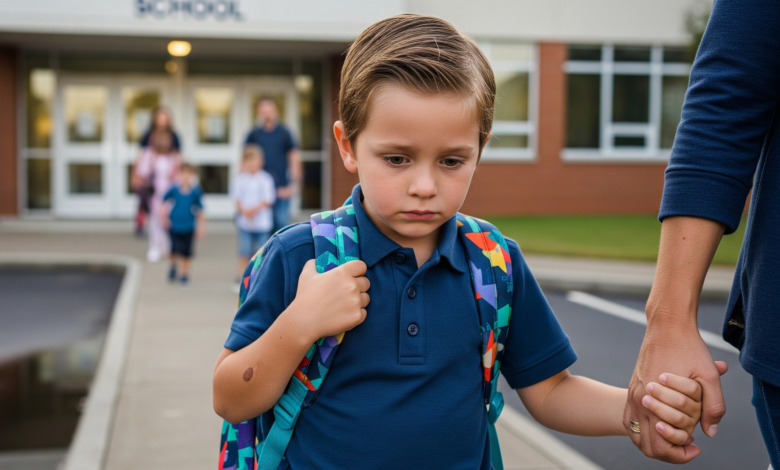How to Ease Your Child’s Back-to-School Anxiety

Understanding Back-to-School Anxiety
Back-to-school anxiety is a prevalent concern that affects many children as they transition from the freedom of summer to the structured environment of school. This anxiety can arise from various factors, including the anticipation of new routines, academic pressures, social dynamics, and the overall change in daily life. Understanding the nuances of back-to-school anxiety is essential for parents and caregivers aiming to support their children effectively.
Common symptoms of this anxiety can vary significantly from child to child, but they typically include feelings of nervousness, increased irritability, stomachaches, or general avoidance of school-related activities. Younger children might express anxiety through tantrums or clinginess, while older children and teenagers may exhibit withdrawal from social engagements or increased disengagement from schoolwork. The manifestations of anxiety can shift with age, reflecting each developmental phase’s unique challenges and expectations.
Transitions in routine, such as shifting from a leisurely summer schedule to the more structured environment of school, can dramatically influence a child’s emotional well-being. For instance, preschoolers may fear separation from their parents, while adolescents might worry more about fitting in with peers or facing academic expectations. These factors contribute to a growing sense of anxiety regarding the school year ahead.
Furthermore, psychological factors play a pivotal role in shaping a child’s experience of back-to-school anxiety. Cognitive patterns, previous school-related experiences, and individual temperament can all influence how a child perceives and reacts to returning to school. An understanding of these factors allows parents and educators to address anxiety more effectively, creating a supportive atmosphere that can ease the transition and help children navigate their feelings with resilience.
Recognizing the Signs of Anxiety in Children
As the back-to-school season approaches, many children may experience a range of emotions, and it is essential for parents to recognize the signs of anxiety that may emerge. Anxiety in children can manifest in various emotional, physical, and behavioral symptoms, all of which warrant careful attention and understanding from caregivers.
One of the most common emotional symptoms is persistent worry or fear. Children may express their concerns about academic performance, social interactions, or the overall transition back to school. These feelings can sometimes lead to heightened irritability or mood swings, indicating that a child may be struggling with anxiety.
In addition to emotional signs, anxiety can also cause physical symptoms. Children may complain of stomachaches, headaches, or other unexplained aches that seem to coincide with school-related activities. These physical manifestations are often stress-related and can serve as red flags for parents looking to identify the underlying issues contributing to their child’s discomfort.
Behavioral changes are also telling indicators of anxiety in children. Some children may withdraw from friends, family, or activities they previously enjoyed, while others might exhibit aggressive behaviors or outbursts when faced with school-related discussions. Observing these behavioral shifts is crucial for parents, as they can signify underlying anxiety that needs to be addressed.
Ultimately, recognizing these signs of anxiety is the first step in supporting your child during the back-to-school transition. By being attentive to emotional, physical, and behavioral changes, parents can better understand their child’s needs and provide the necessary support to help them cope with their feelings of anxiety effectively.
Creating a Positive Environment at Home
Creating a supportive and calming environment at home is essential for easing your child’s back-to-school anxiety. One of the first steps parents can take is to maintain open lines of communication. Encourage your child to express their feelings about returning to school. Actively listen to their concerns without judgment, validating their emotions. Engaging in regular conversations can help foster an atmosphere of trust, allowing your child to feel more comfortable discussing any apprehensions they may have.
Establishing a daily routine can also play a significant role in reducing anxiety. Children thrive on structure as it provides them with a sense of security and predictability. Consider outlining a morning schedule that includes waking up at the same time each day, having breakfast, and preparing their school materials. After school, set aside time for homework, relaxation, and family activities. Consistency in daily routines can help mitigate feelings of uncertainty that often accompany the transition back to school.
Encouraging positive self-talk is another vital element in creating a nurturing home environment. Teach your child to identify and challenge negative thoughts, replacing them with more supportive and optimistic statements. For instance, instead of thinking, “I will never make friends,” encourage them to say, “I can meet new friends by being friendly and open.” This shift in mindset can significantly bolster their confidence as they return to school.
Finally, setting up a dedicated study space at home can make a substantial difference in how your child approaches their academic responsibilities. Choose a quiet, well-lit area free from distractions, and equip it with essential supplies such as notebooks, pencils, and any educational materials. Personalizing this space with motivating decor or their favorite colors can make it feel inviting and safe, thereby helping your child associate it with productive learning.
Preparation and Planning for the School Year
Preparation is a critical component in alleviating back-to-school anxiety in children. A gradual transition into school routines can help reduce feelings of uncertainty and fear. Start by establishing a consistent daily schedule several weeks before school begins. This schedule should mimic the upcoming school routine, including wake-up times, meal times, and homework sessions. This approach allows children to gradually adjust their internal clocks and feel comfortable with the new routine.
Familiarizing your child with their new school environment is another proactive strategy. If possible, visit the school together prior to the first day. Walk through the hallways, locate important areas such as the classroom, cafeteria, and restrooms, and allow your child to explore. Meeting their new teachers beforehand can also help build a sense of familiarity and comfort. Encourage your child to ask questions, addressing any concerns they may have about the school layout or daily activities.
Discussing what to expect throughout the school year is essential. Engage in open conversations about the subjects they will learn, any extracurricular activities they are interested in, and the social aspects of school life. By preparing them mentally for these experiences, you are encouraging resilience and reducing apprehension. Sharing stories about your own school experiences can also provide reassurance and promote a healthy dialogue about feelings of anxiety.
Moreover, attending orientation events together can play a vital role in easing anxiety. These events often provide opportunities for children to meet their peers and interact with teachers in a welcoming environment. Viewing these gatherings as valuable bonding experiences reinforces the positive aspects of returning to school. Overall, preparation and planning are foundational steps in mitigating back-to-school anxiety and fostering a smoother transition into the academic year.
Encouraging Healthy Coping Mechanisms
As children prepare to return to school, anxiety can become a prevalent issue. It is crucial for parents to equip their children with healthy coping mechanisms that will enable them to manage their stress effectively. One approach that has gained popularity is the use of mindfulness techniques. Mindfulness encourages children to focus on the present moment, helping them to become more aware of their thoughts and feelings without judgment. Techniques such as guided imagery or simple meditation exercises can significantly lessen feelings of anxiety and promote a sense of calm.
Another effective way to combat back-to-school anxiety is through breathing exercises. Teaching children simple techniques, such as taking deep, slow breaths—where they inhale for a count of four and exhale for a count of six—can be beneficial. This practice not only helps to alleviate immediate feelings of stress but also serves as a valuable tool that children can carry with them into various scenarios throughout the school year. With regular practice, these breathing exercises can become a natural response to anxiety-inducing situations.
In addition to mindfulness and breathing strategies, physical activity plays a vital role in managing anxiety. Engaging in regular exercise releases endorphins, which can improve mood and reduce stress levels. Parents can encourage their children to participate in sports or active hobbies that promote both physical health and social interaction. Activities such as team sports or dance classes foster a supportive environment where children can build friendships, enhancing their overall emotional resilience.
Ultimately, encouraging children to explore these coping mechanisms can transform how they approach stressful situations. By fostering a routine that includes mindfulness, breathing techniques, and physical activities, parents can help their children navigate the challenges of returning to school with confidence and ease.
The Role of Communication and Active Listening
Effective communication serves as a cornerstone in alleviating children’s back-to-school anxiety. Establishing an open dialogue where children feel comfortable sharing their feelings is essential for fostering trust and understanding. Engaging in conversations about their experiences, worries, and anticipations regarding the upcoming school year can significantly reduce their stress levels. Parents and caregivers should create a safe space where children can express their emotions without fear of judgment.
Actively listening to children is a critical component of effective communication. This involves not only hearing what they say but also understanding the underlying emotions associated with their words. Parents should approach conversations with an empathetic attitude, allowing their children to articulate their thoughts and feelings. Techniques such as maintaining eye contact, nodding, and responding thoughtfully will demonstrate to children that their concerns are taken seriously. By validating their feelings, parents can help children feel acknowledged and supported during this transitional period.
Encouraging discussions about expectations for the new school year can also play a vital role. Parents might ask questions such as, “What are you looking forward to in school this year?” or “What are some things that make you nervous?” These open-ended inquiries allow children to share both their excitement and apprehensions. Providing opportunities for children to voice their thoughts contributes to their emotional well-being and helps them process their feelings effectively.
In nurturing a supportive environment, parents can facilitate constructive dialogue that empowers children to navigate their back-to-school anxiety. Through consistent communication and active listening, caregivers can better understand their children’s perspectives, thereby fostering a sense of security and readiness as the new school year approaches.
Seeking Professional Help When Necessary
As parents strive to ease their child’s back-to-school anxiety, there are instances where anxiety may be more severe and require professional intervention. Recognizing the signs that your child needs help is the first step. Signs may include persistent worry that interferes with daily activities, difficulty in coping with school-related stress, or physical symptoms such as stomachaches or headaches that accompany anxiety. If these symptoms seem overwhelming, it is prudent to consider seeking assistance from a qualified professional.
When deliberating on the need for outside help, parents should explore various types of specialists who focus on children’s mental health. Pediatricians, child psychologists, and licensed clinical social workers are commonly recognized professionals who can provide the necessary support. Each of these specialists brings unique expertise tailored toward addressing children’s emotional and behavioral issues, including anxiety. For instance, child psychologists often employ therapeutic techniques aiming to help children process their feelings and develop coping strategies.
There are several therapeutic approaches available for young children experiencing anxiety. Cognitive-behavioral therapy (CBT) is a popular choice, as it encourages children to identify and challenge negative thought patterns. Play therapy is another effective method that allows children to express their emotions through play, making it easier for them to address their anxiety in a safe and nurturing environment. In some cases, family therapy may also be beneficial, as it involves the entire family unit in the healing process.
Choosing the right professional for your child hinges on several factors, including the specialist’s qualifications, experience with childhood anxiety, and their approach to therapy. It is essential for parents to feel comfortable and confident in the chosen professional, as this can significantly impact the effectiveness of the treatment. Engaging in initial consultations, asking thorough questions, and considering recommendations can facilitate the right choice for your child’s unique needs.
The Importance of Routines and Consistency
Establishing routines and maintaining consistency is crucial for easing anxiety in children, particularly as they transition back to school. The beginning of the school year can be a time filled with uncertainty and apprehension, and predictable routines can provide a sense of security. When children know what to expect, it can significantly reduce their anxiety levels and help them feel more in control of their environment.
Creating a structured daily plan is essential, and this can be achieved by outlining specific times for various activities, such as waking up, having breakfast, attending school, completing homework, engaging in playtime, and winding down for the night. By incorporating designated times for each task, children are less likely to feel overwhelmed, as their day is compartmentalized into manageable segments. This also encourages the development of good habits, such as time management and responsibility.
For instance, establishing a morning routine that includes waking up at the same time each day, eating breakfast together, and reviewing the day’s schedule can set a positive tone. In the evenings, families can create a winding down routine that allows time for relaxation and connection, such as reading together or talking about their day. Integrating these consistent patterns can foster a feeling of stability, which is particularly beneficial for children prone to anxiety.
In addition, parents can involve their children in the planning process to enhance the effectiveness of these routines. By allowing children to contribute ideas on what activities they enjoy or how they would like their day structured, they may feel a greater sense of ownership and engagement in their routines. The more children participate in the creation of their daily structure, the more likely they are to adhere to it and find comfort in the predictability it provides.
Celebrating Progress and Building Resilience
As children return to school, it is essential to recognize and celebrate their progress as they navigate this transitional period. Acknowledging small victories can significantly enhance a child’s confidence and motivation. Setting achievable goals for the first few weeks back can provide children with a sense of direction and purpose. These goals should be specific, measurable, and attainable, allowing for a clear understanding of what success looks like. For instance, encouraging a child to complete their homework on time or make new friends can be excellent starting points. Every time these goals are met, parents can take the time to celebrate these accomplishments, no matter how minor they may seem.
Rewards can be a powerful tool in reinforcing positive behavior and building self-esteem. This could range from verbal praise and recognition to small rewards such as a favorite snack or extra playtime. Such rewards not only validate efforts but also instill a positive association with overcoming challenges, which is fundamental in easing back-to-school anxiety. When children see their efforts are acknowledged, they are more likely to engage with their schoolwork and social environments positively.
In conjunction with celebrating progress, fostering a growth mindset is crucial for long-term resilience. Encouraging children to view challenges as opportunities for learning rather than obstacles fosters adaptability. Parents can facilitate this by modeling positive self-talk and framing setbacks as chances to improve. Teaching children that effort is commendable and that mistakes are part of growth helps them develop the confidence to face future challenges head-on. By combining recognition of their achievements with a focus on resilience, we equip children with the tools they need to manage not only their back-to-school anxiety but any difficulties they may encounter in life.





















